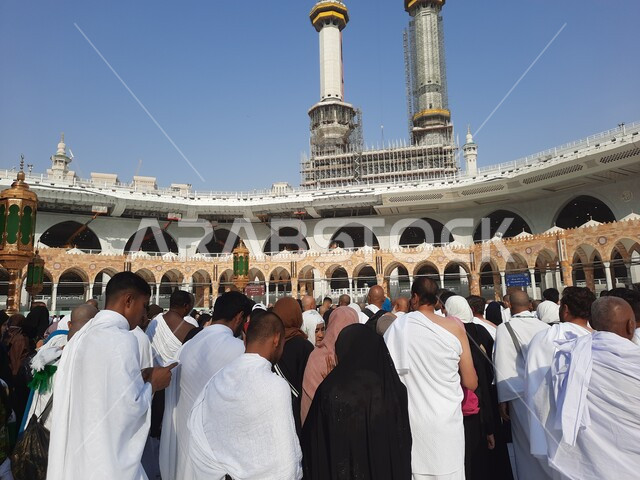Hajj and Umrah are two significant religious pilgrimages in Islam that are often spoken of together, but they are quite distinct from each other in terms of their rituals, requirements, and significance.
Put simply, Umrah is a short pilgrimage that you can do at any time, whereas Hajj takes longer, involves more rituals, and can only be performed at a specific time of year.
They may both be important, spiritual journeys that bring you closer to Allah (SWT), but they’re not the same. So exactly what is the difference between Umrah and Hajj?
What is Umrah?
Umrah is a simpler version of a pilgrimage to the holy city of Makkah, and is sometimes known as the ‘minor pilgrimage’ or the 'lesser pilgrimage'. Umrah comprises certain rituals that can be performed at any time of the year and only takes just a few hours to complete.
Although it’s recommended, it is not a compulsory pilgrimage, nor is it one of the five Pillars of the Islamic religion. It’s still an incredibly sacred journey that millions of Muslims undertake annually to come closer to Allah (SWT).
How is Umrah Performed?
Once you have the correct attire and have entered the sacred state of Ihram, the key rituals to perform Umrah are Tawaf and Sa’i.
Tawaf
Tawaf takes place in Masjid al-Haram, the Great Mosque of Makkah, where you’ll find the ancient house of Allah, the Ka’aba. Here, Muslims journey around the Ka’aba seven times in an anticlockwise direction.
Sa’i
After performing Tawaf comes Sa’i, which involves ritualistic walking and running between the two hills of Safa and Marwa. This is done as a tribute to Hajar (AS), Prophet Ibrahim's wife, as she desperately sought water for herself and her infant son, Ismail. We follow in her footsteps to symbolise the everyday struggle in our lives and how, the most gracious, Allah guides and helps us despite the seemingly impossible.
To perform Sa’i, you start at Safa and make your way towards Marwa until you see a green marker, at which point you run to the next green marker. From there, you make your way to Marwa to complete your first lap.
When you have completed your first lap to Marwa, you do the same in reverse. Sa’i requires seven laps in total. After this, men shave their hair, while women cut a short amount off.
How is Hajj Different from Umrah?
Perhaps the most key difference between the two holy pilgrimages of Hajj and Umrah is that Hajj is the fifth and final Pillar of Islam, but by no means the least important. In fact, this obligatory pilgrimage is something that all Muslims are expected to perform at least once in their lifetime if they’re physically, mentally and financially capable enough to do so.
Although completing Umrah can take just a day, it takes between five to six days to complete Hajj, meaning it’s much more of a time commitment.
Whereas Umrah can be performed at any time throughout the year, Hajj is only undertaken on specific days during the Islamic month of Dhul Hijjah.
Although performing Hajj is compulsary and performing Umrah is only sunnah, both Hajj and Umrah share common rites, and can provide many rewards, spiritual merits, and blessings from Allah (SWT), as both these journeys were undertaken by the Prophet Muhammad (PBUH).
How to Perform Hajj
The holy journey of the Hajj pilgrimage begins much like performing Umrah, by heading to the Ka’aba for Tawaf and then going back and forth between Safa and Marwa for Sa’i. However, there are major differences and additional rituals that come after these.
After Sa’i, Muslims journey to Mina to stay the night before heading to Mount Arafat on the Day of Arafah, the second day of Hajj, and the ninth day of Dhul Hijjah. The Day of Arafah is the holiest day of the year on which pilgrims go to Jabal al-Rahmah, the location where Prophet Muhammad (SAW) is said to have delivered his final sermon, where Muslims perform Wuquf – an act of standing before Allah until sunset.
After their time at Mount Arafat, pilgrims stop by Muzdalifah to pray and spend the night before heading back to Mina on the third day for the Rami al-Jamarat. This is where Muslims throw stones at the largest of three pillars representing the devil.
On the third day of the annual Muslim pilgrimage of Hajj, the four-day festival of Eid al-Adha begins. During this time animals are sacrificed as a tribute to the devotion that Prophet Ibrahim showed to Allah. This is one of the most important Hajj rituals, as food from sacrificed animals is donated to the needy, known as Qurbani or Udhiya.
Undertaking Hajj and performing all these obligatory acts during this religious journey may be difficult and full of physical toil. However it is vital that Muslims do as Allah wills so that he may offer pilgrims forgiveness for their past sins.
While Umrah and Hajj are both spiritual pilgrimages to Makkah with similar rituals, there are key differences. Umrah is a quick, non-compulsory pilgrimage to receive blessings at any time of the year. Hajj is an obligatory, major pilgrimage with more rituals that all Muslims are expected to undertake at least once in their lifetime.
The difference between Hajj and Umrah
- BY
- DATE 11/14/2023


